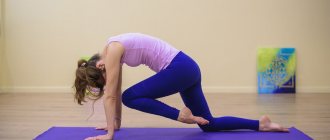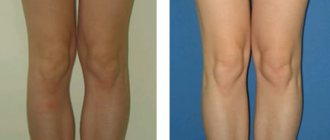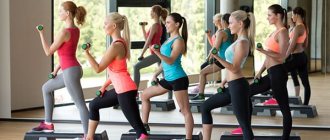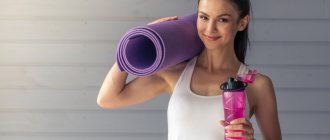A few years ago I looked in the mirror at my own reflection, but I couldn’t understand what was wrong. The body mass index was normal, the volumes were also normal, but the appearance did not bring pleasure. I tried a hundred different ways: difficult and not so difficult, but none of them brought me satisfaction. Until I tried yoga.
For five years, three times a week I have been doing a set of asanas and I feel great. The practice helped me not only to tighten up and lose extra pounds, but also to love myself. Now I'll tell you how.
What is yoga?
In its true meaning, yoga is both physical and spiritual practices aimed at achieving an exalted or even transcendental state. Yoga traditions came to our region from India and changed, adapting to another culture. Nowadays this practice is treated as another course of physical exercises, in addition to everything shrouded in a special oriental atmosphere.
People go to yoga classes in order to gain control over their own body, take a break from the hustle and bustle of everyday work (especially when it comes to aerial yoga), relax, add definition to the body and flexibility to the muscles, or simply lose weight.
Photo: lifehacker.ru
Fundamental Factors of Exercise for Weight Loss
The problem associated with losing weight is relevant and significant nowadays among the fair half of humanity. Many girls and women strive to embody in their appearance all the beauty and grace given by nature, and reveal it in the process of performing exercises that relax and tone the body.
- To overcome a deficiency, you need to know the basis of its birth.
- Excess weight reflects many reasons and circumstances.
Often, lacking the mental and physical strength to overcome life’s troubles, a person finds joy in poor nutrition, which, unfortunately, leads to excess body weight.
Also, the main reason for excess weight may be a passive, sedentary lifestyle.
Benefits of yoga
The ultimate goal varies among practitioners. This can be either an improvement in physical fitness, well-being, or deeper aspects - right up to achieving enlightenment. We recommend reading the answers to the popular question: “How to force yourself to lose weight?”
Photo: planetatain.ru
Regardless of their goals, those who practice any type of yoga increase endurance and strength, but most importantly, almost everyone gains special harmony with the body. They begin to feel it and it is much easier to control it. Coordination of movements improves, and the silhouette becomes much more refined. Static loads stimulate the burning of fat without reducing muscle volume, which generally has a positive effect on the relief, and the development of flexibility makes movements smooth and soft.
If you train conscientiously and follow all the rules, then practice will easily turn you into a graceful, flexible cat.
Many people also note an improvement in mental well-being: a decrease in anxiety levels, normalization of sleep, high spirits, and a feeling of peace.
Morning set of exercises
A morning set of exercises can give you vigor and charge you with positivity for the whole day, and is also indispensable for slimness and flexibility of muscles. For beginners, the following asanas are suitable for morning exercises:
- Mountain Pose (Tadasana).
- Chair Pose (Utkatasana).
- Tree pose (Vrikshasana).
- Bridge Pose (Setu Bandha Sarvangasana).
- “Downward Facing Dog” (Adho Mukha Svanasana).
Contraindications and precautions
Before you start exercising, you should check your health with a specialist. Not all asanas can be performed for problems with joints or heart, or for diseases of internal organs. You should discuss your physical capabilities with your trainer before starting classes. If you exercise on your own, then before performing each asana, carefully study the description - any pose has a list of indications and contraindications.
Photo: shalenaolena.livejournal.com
However, there is a general list of conditions under which exercise is prohibited :
- Mental disorders and borderline states
- Diseases of the cardiovascular system, including organic pathologies: arrhythmias, tachycardia, valve defects, vascular aneurysms or dystrophy of the heart muscle.
- Tumors (malignant and benign).
- Severe TBI.
- Diseases of the musculoskeletal system, as well as serious spinal injuries.
- Cholelithiasis
- Nervous system infections
- Infectious diseases of the circulatory system.
Temporary contraindications include :
- Full stomach.
- Increased body temperature.
- acute respiratory infections and acute respiratory viral infections.
- Fatigue from hard physical work or sports.
- Exacerbations of chronic diseases.
- The rehabilitation period after surgery.
- Sunstroke and hypothermia.
- You should be especially careful with yoga if you are obese due to concomitant diseases.
Menstruation in women is not a contraindication to exercise, however, trainers recommend reducing the load during this period and avoiding power and inverted poses. In case of severe pain, you should stop doing yoga.
In order for the practice to be not only effective, but also safe, you should follow simple rules:
- Do not practice on a full stomach - many asanas have an effect on internal organs. Doing yoga on a full stomach can provoke the development of gastrointestinal diseases, not to mention simple nausea.
- You should move from one asana to another smoothly and carefully so as not to inadvertently damage the ligaments and joints.
- You shouldn’t take asanas “hurriedly” - of course, many people want to be able to perform complex exercises, but the main rule of yoga is moderation and gradualness. This makes it much easier to avoid injury. For difficult poses, the use of auxiliary equipment is also recommended: bolsters, folded towels, bricks and belts. Don't neglect the opportunity to make your practice easier!
- If you are studying in a group, then listen carefully to the instructor and follow all his instructions. Ask questions if you don’t understand something - your health directly depends on your awareness!
- During independent exercises, listen to your body - there should be no pain, and the appearance of unpleasant sensations is the first signal to stop performing the asana or movement.
But the most important thing is to enjoy your activities: they should bring joy, not irritation.
Photo: ajnj yandex.kz
How much yoga do you need to do to lose weight?
A clear answer to the question of how much yoga you need to do to lose weight can only be answered individually. This depends on the amount of excess fat tissue and the energy consumption of the asanas. The more and more intensely you move during exercise, the greater the calorie deficit will be created.
Energy consumption of asanas
The intensity of the load and the ability to burn a certain number of calories per hour of exercise depends on the type of exercise. The greater the intensity and magnitude of the load on the body during the implementation of the complexes, the more calories will be burned. Accordingly, static asanas do not have such capabilities. Their benefits include improving blood circulation, saturating organs with oxygen, and improving metabolism.
Duration of classes: is 15 minutes enough?
If it is not possible to devote more time to practice, you can achieve results even with short sessions. For beginners, 15 minutes will be enough for the body to tone up and develop the habit of daily physical activity.
For a noticeable weight loss effect, this is especially true for the abdomen and hips, exercise should be long. If we are talking about an active complex with the goal of getting rid of extra pounds, then ideally classes should last at least 1 hour.
How is yoga different from Pilates?
Many consider yoga to be something akin to “ancient” physical education, unintentionally mixing it with such a sports direction as Pilates. In fact, these two practices have a number of significant differences.
| Pilates | Yoga |
| A system created by an amateur athlete at the beginning of the last century. Includes the basics of exercise and physical therapy. | A system of eastern practices aimed at the harmonious development of body and spirit, improved over many centuries. |
| The exercises are dynamic, but not too fast. They strengthen muscles and the spinal column, increase strength and endurance. | A variety of static exercises aimed at strengthening the musculoskeletal system and developing coordination. |
| Suitable for people with any level of physical development, has a minimum of contraindications, and often replaces physical therapy during rehabilitation. | It has many different directions, differing in intensity levels. Therefore, yoga has many contraindications. |
| For effective Pilates classes, special exercise machines, fitballs and bands are used. | Does not require additional equipment. |
| Doesn't focus on stretching. | Many asanas are aimed at stretching muscles and ligaments. |
| Designed to improve the health of the body, without overwork or overextension. | Aimed at harmonizing body and spirit, it forces you to work not only with your muscles, but also with your mind. |
| Suitable for people of all ages and constitutions, has a minimum of contraindications. | Many types of yoga require significant physical fitness and good health. |
These activities also have a number of similarities. They:
- develop strength, stamina and endurance
- allow you to work your entire body without exception
- correct posture and stretch the spine (also read about morning exercises for weight loss)
- work deep muscles, relieving tension and pain
- They help you lose weight, polish your figure, giving it slimness and grace.
How does yoga help with weight loss?
Yoga is often associated with a boring and not very demanding form of exercise. Nothing could be further from the truth - physical work while performing asanas helps burn calories and cleanse the body of toxins. Daily practice enhances the regeneration of the body, which requires a lot of energy, in return giving great vitality. Regeneration of muscles and tendons after a yoga session lasts from the end of the exercise until the end of the next day. Efficient metabolism is important for maintaining optimal weight. Yoga positions strengthen, lengthen, relax muscles, and effectively sculpt the figure.
Types and levels of yoga
Modern studios offer dozens of different types of practice to suit every taste, and elements of yoga have seeped into many sports areas.
Hatha yoga
Photo: ajnj lifegid.com
A classic form in which the emphasis is on the body, building asanas and preparing the mind for meditation. Hatha yoga is what most fitness clubs and studios offer. The practice is divided into the following subtypes:
- Ashtanga Vinyasa Yoga is a dynamic course, with a lot of strength exercises and a fixed sequence of movements. It has several levels, depending on the yogi’s training.
- Iyengar Yoga is named after its “inventor.” It is aimed at meticulously constructing all asanas, pays great attention to detail and involves a large static load. In order to set up a pose correctly, practitioners use a large number of auxiliary devices: rollers, pads, tapes and ropes.
- Yoga 23 - the emphasis in this practice is mainly on strength training and proper breathing. Often, trainers use a metronome to count cycles.
Hot yoga and Bikram yoga
Photo: yogadome.com.ua
The most intense type. These two types of practice are similar in that they are carried out in a heated room. The studio contains a heater and humidifier. The air temperature is maintained at 38-40°C. In such an atmosphere, it is much easier to relax not only the mind, but also the muscles. And with relaxed muscles it is easy to take even the most difficult poses.
The only difference between these practices is that Bikram yoga involves a fixed sequence of asanas, and during hot yoga classes, everything depends on the desire and mood of the trainer.
Aerial yoga or fly yoga
Photo: yoga-anahata.com
This type differs from hatha yoga in only one way - all asanas are performed in special, hanging hammocks. This type is very popular because in a suspended state the load on tendons and ligaments is reduced, and even complex poses are much easier.
Kundalini yoga
Photo: encrypted-tbn0.gstatic.com
Aimed at achieving harmony with your body through long-term fixation in simple asanas and meditative concentration. During classes, the reading of mantras is often used. Can be combined with mudra yoga.
Mudra yoga
Photo: brightstuffs.com
Or as it is also called - finger yoga. A special practice consisting of making certain shapes from your palms. It can exist in tandem with another type or as an independent practice. Mudras help to cope with sudden outbursts of emotions and find peace of mind.
Pair yoga or Acroyoga
Photo: lokostyle.ru
Suitable for those who find it boring to study alone. According to the name, it involves working in pairs - building asanas with the support and help of a partner. This is somewhat inconsistent with the idea of yoga as a way to immerse yourself, but it perfectly helps to cope with mistrust and destroys conflicts. In addition, acroyoga requires significant physical activity, which is great for losing extra pounds.
Raja Yoga
Photo: static.wixstatic.com
This is a classic type that views a person as a single system of mind, body and soul. Therefore, in addition to asanas, those who want to practice Raja Yoga undergo a kind of psychological training.
It is here that we have to overcome several steps, including:
- Yama - working with behavior.
- Asana - working with the body.
- Pranayama - working with breathing.
- Dharana - working wisely.
- The highest level of raja yoga is samadha, enlightenment. Few people achieve it, but the aspiration is the goal of all practice.
Fitness yoga
Photo: recsports.virginia.edu
The most “unspiritual” practice. Fitness yoga has lost all of its “energetic” component, focusing on developing the body through asanas. Maybe both strength training and cardio. It is often also called “yoga on a ball” due to the use of a fitball as equipment.
Surat Shabd Yoga
It is practiced only with the participation of a guru, whose students tune into his wave, and thus receive purification. Guru yoga is a way to escape the wheel of samsara by following the teacher. How true this is is difficult to say, but no one denies that it is quite difficult to comprehend Eastern wisdom without a teacher.
Yoga Nidra
Photo: tutknow.ru
The calmest of all practices. Throughout the lesson, students are in Shavasana or “sleeping person’s pose” and listen to the meditative speech of the instructor, who slowly speaks through all parts of the body, leading them to relaxation. This type of exercise is not very suitable for losing weight, but it helps fight stress.
The choice of direction of study directly depends on your goals:
- Dynamic types of yoga are perfect for losing weight: hatha, bikram, fitness yoga.
- For deeper psychological development, Raja or Kundalini Yoga.
Yoga rules
The physical side of practice that is needed to lose weight is not much different from other sports. And to achieve success during classes, you should follow a few simple rules.
Start
Before you start exercising, you should consult with your doctor regarding restrictions. Yoga should improve health, not become an additional risk.
Start performing asanas with a positive attitude and a free mind. Trust your body, but don't demand quick, significant results from it. The peculiarity of yoga is its leisurely and gradual nature. Therefore, you will have to be patient.
Class time
The choice of time for classes directly depends on your desires and capabilities. Many trainers recommend starting practice in the morning, immediately after waking up. At this time, the stomach is still empty, which also has a beneficial effect on well-being. However, you can perform asanas at any time convenient for you. The only condition is two hours after eating. The recommended duration of classes is one hour. During this time, you will have time to work all the necessary muscle groups and achieve the required relaxation.
Depending on the intensity of the training, it is recommended to practice from three times a week to daily classes. The main thing to remember is that the peculiarity of yoga as a direction is that it requires dimension and consistency. Only regular repetitions can lead you to your goal.
Tips for Newbies
Pay attention to the general recommendations for beginners who want to lose weight with yoga. Top 10 tips:
- Take a few lessons from an instructor to learn the basics and learn to feel your body.
- Plan to practice in the morning.
- Do the exercises thoughtfully. Don't chase quantity, watch quality.
- Create a calm environment for studying. Warn your loved ones so that no one distracts or disturbs you.
- Ventilate the room before class.
- Buy a mat and a comfortable workout outfit. This will make your practice more enjoyable and effective.
- Start your session with a warm-up to warm up your joints and muscles and avoid injury.
- Master proper breathing.
- Gradually increase the time allotted for exercise. Start with 15 minutes and work up to an hour.
- Don't force things. Stay calm and be happy with the result you have here and now.
Important! Yoga requires systematicity!
Beginners can do the practice every other day, and over time make it daily. Start simple and aim for more complexity. Don't worry about lack of strength or flexibility. Daily exercise will help you gain confidence and stamina. Don't compare yourself to others, look only at your results. Each person is unique and everyone has their own path!
Breathing technique
Harmony with the body during yoga is achieved only during complete unity and immersion into oneself. To do this, practitioners recommend paying special attention to breathing techniques.
Video with breathing rules during yoga practice.
Each exercise has its own characteristics, but the general rules of breathing boil down to:
- Try to breathe with your stomach. It is this kind of inhalation that is more complete, causes the diaphragm to move and the lungs to open. When breathing through the stomach, the blood is well enriched with oxygen.
- Breathe slowly and measuredly. Do not hold your breath while adjusting asanas, do not take shallow shallow breaths and do not try to shorten the time of doing exercises by breathing. For each asana there should be at least five to seven cycles of inhalation and exhalation.
- Breathe consciously. It is important to understand at what point the body inhales, bursting, and when it exhales. This is important for controlling body position and smooth transition from one position to another.
- Inhale through your nose, not your mouth. Not only is this better for your health, but it also helps you concentrate on breathing slowly rather than taking small sips of air.
Learning to breathe correctly is often quite difficult: inhaling and exhaling is something that we do completely unconsciously, following the patterns laid down from childhood. You can learn breathing exercises separately from the main classes or combine them with asanas.
Cleansing Breath
Performed in the “mountain pose” asana. Stand up straight, place your arms along your body and your feet next to each other. Stretch the top of your head up, trying to feel the spinal column and take five to seven slow breathing cycles. Inhale through your nose and exhale through your mouth, without puffing out your cheeks.
Cleansing breathing technique.
Breathing with delay
Pauses after inhalation and exhalation train the respiratory muscles. This exercise can be performed in any position, as long as the main condition is met - an open chest. Breathe slowly and deeply, holding your breath for three to four counts after inhaling, and then after exhaling.
Rhythmic breathing
The goal is to feel your body, find its rhythm and follow it. It is performed while sitting with your legs extended forward. The back and arms should be straight, but free. Breathing should be done by counting the heartbeat: six beats per inhale, three per pause and six beats per exhale.
We invite you to watch a video course from Anton Ivanov, in which he talks and shows how to breathe during various exercises.
Remember that during breathing practice new processes are activated that are unfamiliar to your body. If you feel dizzy or other unpleasant sensations, stop the practice immediately and relax.
Meditation while eating
How not to convey - the secret of a Zen Buddhist monk
So, we have already understood that yoga helps us to be calm, mindful, and, therefore, protects us from uncontrolled eating. Well, it's time to master meditation! You don’t have to go to the Himalayas to do this. Vice versa! It is best to meditate in a normal environment. The famous Vietnamese Zen Buddhist monk Thich Nhat Hanh even introduced “Household Meditation Lessons,” where we practice while washing dishes or walking. For those losing weight, meditation while eating is best. Here she is:
Mindful eating is an important practice. So, we turn off the TV, gather as a family in the kitchen and act together for five to ten minutes, setting the table and finishing everything that needs to be done. When the food is on the table and everyone is seated, we practice breathing: “Breathing in, I calm my body. As I exhale, I smile.” We repeat three times.
After breathing and smiling at each other, we turn our eyes to the food and look at it for a few seconds. “Each piece contains a piece of the sun and earth. Imagine we can see and taste the entire universe in a slice of bread! Contemplating food before starting a meal and conscious eating will bring a lot of happiness,” the monk will assure. Let’s add on our own: you also won’t attack the food and swallow it all at once. This means you will feel full in time!
Variation of virabhadrasana with twisting. Photo: Personal archive of Elena Siderskaya
Exercises at home
Of course, there is nothing better than working out with a coach who can point out mistakes. But nothing stops you from practicing on your own. The main thing is to listen to your body and not overwork. The Yoga for Weight Loss - Lose Weight app on the Play Store can help you with creating a lesson program and mastering asanas in pictures.
We offer you several video options with yoga lessons for weight loss from leading instructors, with an emphasis on different muscle groups.
Getting rid of fat on the stomach and sides
A thin waist is important for every woman. This video from Unagrande yoga is designed so that both the rectus and oblique abdominal muscles are involved during the class.
Video from Unagrande YogaClub for the abdomen and sides.
Remember that stress on the abs during menstrual periods is not recommended.
Working out the thighs and buttocks
This part of the body is considered one of the main pillars of the body. Well-developed muscles strengthen both the physical and psychological support of a person. To quickly lose weight on your thighs, use a set of fairly simple asanas.
Video from Unagrande YogaClub for beautiful buttocks.
For a thin waist and healthy back
Low mobility and a sedentary lifestyle have a bad effect on the muscular corset of the back and, as a result, on posture. A video lesson of asanas for the back will allow you to relieve tension in a day, eliminate pain and create truly royal posture.
Video from Unagrande YogaClub with a set of exercises for your waist and posture.
Strengthening your legs and knees
Exercises for legs and knees from Unagrande yoga will allow you to pump up your calves and make the silhouette of your legs smoother. It will also help develop joint flexibility and relieve tension accumulated during the day.
Watch the video from Unagrande YogaClub on your feet.
For hands and fingers
Mudras are recommended to be combined with other types of practice for more complete immersion into oneself and to enhance the effect. In addition, mudras will make your palms thinner and your fingers more flexible.
Mudras from Elena Glushkova.
For face and cheeks
No weight loss program can do without exercises for the facial muscles. Regular face yoga classes will tighten your cheeks, remove bags under your eyes and highlight your cheekbones, and promote effective facial rejuvenation without any plastic surgery!
Video from yoga instructor, Elena Rodicheva. Exercises for all facial muscles.
For two
Acroyoga is more like a challenge or test of trust and endurance. However, couple exercises can also be done at home with your husband, mother or child. The main thing is to listen to yourself and your companion!
We offer you to watch a couples warm-up, basic acroyoga exercises and Thai massage.
Why do we overeat
The answer most likely lies in psychological problems. We're obviously eating something. Fatigue, dissatisfaction, stress, resentment, loneliness, anxiety... I could go on and on - but you get the point. And this state of “I want something sweet and harmful, but more of it” can be stronger than us. We console ourselves with food, allowing us to feel joy and pleasure at least for a while.
But it is yoga that can provide the same state. Or rather, it returns the taste for life to those who have lost this state, and is able to fight depression and lack of self-confidence. Ask any yogi and even doctors.
But how does it work? That’s the secret: this effective and centuries-proven practice, through physical exercise, affects a person’s emotions and thoughts. Our mind calms down and comes to a neutral state. The cells of the whole body are saturated with oxygen and all organs begin to work better, we receive a powerful surge of strength. Vigor appears, the desire to live and rejoice again.
Eating habits are changing
And those who start doing yoga change their eating habits. Yes, not right away. But it happens by itself. Some people give up meat and bread and start eating more fruits and vegetables. For some, sodas and cakes become tasteless, they feel “chemical”, and they begin to drink more water and choose dried fruits instead of the usual sweets. No one is forcing anyone to change. This is a natural reaction of the body in response to practice. A person begins to crave healthy food. And, what is important, it no longer seems as terrible to him as before (“What are these? Dates? Ew!”) - from now on he wants to eat exactly this way and no other way.
And another positive thing. Over time, less and less food will be enough to satisfy you. Yes, you can’t really go wrong with yoga - try it, bend over when there’s a kilogram of kebabs inside. This is where it gets to the point of nausea. You will see that you will want to exercise in a light, half-starved state - and it is comfortable.
This is some advice for beginners. Until you have made any changes in your diet, try to stick to these rules.
Tips for proper nutrition
- You need to do yoga on an empty stomach. If you ate something light, for example, a salad of greens and vegetables, an hour or an hour and a half should pass, and only then lay out the mat. After a heavier meal, it will take a little longer. Three to four hours.
- Drink more water. Yoga activates metabolic and cleansing processes in the body, which is why it is so important to drink. But not in one gulp at the end of the class, but in small sips after each asana (that’s what yoga poses are called).
- Read food labels at the store. This will sober you up and protect you from buying harmful things. At least once out of ten.
- The stomach also wants to rest. Don't load him up with heavy food late in the day. And remember that late in the evening, when you are at home in the refrigerator, your stomach will already be asleep. It won't start working until tomorrow morning. And all the food that gets inside now will just lie there as dead weight. Do you need this?
show more
When to expect results from yoga classes
This is a myth: that yoga is all so leisurely, meditative and is not capable of “pumping up” the body. There are asanas, when performed, seven will come down later. And skilled instructors are able to give such sets of exercises that beginners can barely carry their legs after class. At the same time, they smile and thank the coach. Of course, such a load can be obtained at home (watch our video tutorials for this material). But after it, be sure to do shavasana - a relaxation pose.
Yoga works very effectively with the body. Strengthens muscles, makes them elastic, burns excess fat. And, most importantly, it heals the body as a whole. That is, losing weight is actually a pleasant bonus. A natural consequence of yoga, which returns youth, strength and beauty to a person.
Be prepared right away that you will not feel the effect immediately. Some people will have to wait two months, others even six months, before you see how your stomach tightens and your waist appears. But I assure you, you will like the result. Because there will be no more backsliding, as with a long period of giving up sweets. The only important thing is to continue studying.
Five secrets why we lose weight with yoga
- So, as we already understood, it relieves the stress that we eat.
- Helps improve nutrition. Yoga practitioners suddenly begin to listen to themselves and choose healthy foods and take care of themselves.
- Helps improve digestion. The fashionable word “detox” is exactly applicable to yoga. During classes, cleansing processes are launched, waste and toxins are removed from the body.
- In yoga, much attention is paid to proper breathing. And this is not just like that. During breathing practices, the body is saturated with oxygen, all organs begin to work better. Result: metabolism accelerates, less fat accumulates.
- Yoga works great on muscles. It reaches the most inactive places where fat accumulates, stretches even the deepest muscles.
Photo: @dash.yoga
Benefits of practice
Of course, yoga was created not only for weight loss. Here are the main beneficial effects of exercise:
- Yoga slows down the aging process.
- Relieves back pain, removes spinal curvature, osteochondrosis, and salt deposits.
- Strengthens muscles, restores flexibility to joints.
- Restores reproductive function in women and increases potency in men.
- Thanks to intensive breathing during exercise, it saturates the cells with oxygen, and all systems begin to work more efficiently.
- A natural massage of internal organs occurs. Yoga perfectly removes waste and toxins and relieves constipation.
- Cures migraines, asthma, arthritis, insomnia.
- Helps (attention!) lose excess weight.
- Gives the whole body and brain deep relaxation.
- Meditation included in yoga classes helps strengthen the immune system and reduce stress levels.
Photo: @patrikiclub, @studiya_karimovoy, @howtogreen, @mary.bi.yoga
Features of yoga
Like any other physical practice, yoga has its limitations depending on age or health. It is very important not to neglect them so as not to harm yourself.
For beginners
If you are just getting acquainted with the world of yoga or have not exercised before, focus your attention on simple poses and proper breathing. This way you can avoid injury and overexertion.
Photo: ajnj vo-sport.com.ua
Move on to complex asanas when you feel confident and can control your body. Master the 5 basic poses first and then move on to something more challenging.
For full
Being overweight is not a contraindication to yoga. On the contrary, many obese people are very flexible, which allows them to easily perform complex asanas.
It is not recommended to perform the plow pose, as body weight puts a lot of stress on the thyroid gland.
Feel free to unload your body with straps, bands and pads. Many studios specializing in yoga for fat people have all the necessary equipment in the room.
Photo: www.jv.ru
Perform all asanas at a comfortable rhythm and at a time that is comfortable for you.
For women
Yoga for women has its own characteristics only during menstruation. During critical days, it is recommended to reduce the intensity of exercise, not strain the abdominal muscles, and also avoid inverted poses. If you exercise every day, then you can take a little break from exercise during this time.
Photo: woman.rambler.ru
For nursing mothers
Yoga during lactation should not be aimed at developing strength. Excessive stress on the body can lead to disruptions in milk production.
Calm poses and asanas aimed at opening the chest are recommended.
You should not over-strain your abdominal muscles, and pumping your abs in the classical sense of this exercise is strictly prohibited!
For children
Yoga for children includes a whole range of exercises aimed at helping the child understand his body and develop coordination of movements.
It is recommended for healthy children to attend such classes, starting from the age of three. Lessons for children are more like a game, during which little yogis are asked to fantasize and copy different animals.
Photo: yoga.ua
Asanas that can negatively affect the hormonal levels of children are excluded from practice.
For men
In fact, yoga for men is not much different from yoga for women. Is that the stronger sex has fewer restrictions due to the lack of critical days.
Also, trainers recommend giving preference to poses that open the hip joints - such asanas normalize blood circulation, prevent the development of venous stagnation and increase potency.
Yoga classes for weight loss
Do you want yoga for weight loss to work really well? So that literally every morning you feel that you are becoming lighter? Then, after completing a set of asanas, do not be lazy to practice breathing exercises (pranayama) and meditation. Meditation + pranayama + asanas - this is the magic recipe for yoga for weight loss. Start every morning with yoga, including all three components in your practice, and the result will not take long to arrive.
Meditation to burn fat
Yoga restores hormonal balance in the body through calming the mind and achieving inner harmony. But this is not the only reason why yoga helps you lose weight. Let's look at what exercises a typical yoga class consists of in a studio or fitness club.
Usually a yoga lesson begins with meditation . In almost any class, you will first be told to sit quietly for 10 minutes and be aware of what is happening inside and outside.
Many studies, by the way, confirm that the regular practice of meditation alone already has a positive effect on health, hormonal levels and leads to weight normalization. In addition, meditation develops awareness, which leads to improved eating behavior and a more conscious approach to nutrition. This is also important.
Pranayama
The second thing you will do in yoga is pranayama , that is, breathing exercises.
Some pranayama are designed to train one very important muscle in our body - the diaphragm.
A constant sedentary lifestyle leads to the fact that the diaphragm simply stops working at full strength and becomes weak and tight. And most Western training systems practically do not pay due attention to this muscle. But not yoga.
In yoga, great importance is placed on proper breathing and the development of the diaphragmatic way of breathing. That is why you will do a lot of pranayama and allow your diaphragm to work hard and develop to its full potential.
The movement of the diaphragm during breathing has enormous benefits for the entire body.
- Firstly, each expansion and contraction of the diaphragm performs a gentle massage of the internal organs - heart, liver, pancreas, gall bladder. This leads to their cleansing and stimulates their work.
- Secondly, the diaphragm directly affects the digestion process, affecting the stomach, unless, of course, we forget to actively move it.
- And thirdly, with a full deep exhalation, the diaphragm, rising high, affects the solar plexus area, where tens of thousands of nerve endings intertwine, this leads to stimulation of the parasympathetic nervous system, which is responsible for rest and restoration of the body.
The parasympathetic nervous system is often suppressed as a result of modern man's constant pursuit of goals. Constant tension, stress, nervous activity blocks the body's healing processes and restoration of strength. And yoga masters, well aware of this, have developed breathing exercises that bring two opposing nervous systems - parasympathetic and sympathetic - into balance. This promotes weight loss much more than constant exhausting diets and exercise.
Probably the most famous pranayama for weight loss is called uddiyana bandha . Today many people know this exercise as “vacuum”. So this “modern” vacuum is an integral part of the yogi system, which has existed for many thousands of years.
You can watch how to perform uddiyana bandha correctly in this video:
Lesson program for the morning
One of the best yoga complexes in the morning is considered to be “Surya Namaskar” or “Sun Salutation”. These exercises do not take much time, but fill the body with energy and vigor for the whole day.
Try to perform asanas with your face facing the sun. Make all movements smoothly, as if dancing. There are a total of 12 asanas in Surya Namaskar, which are recommended to be performed from 3 to 24 circles in a row. On average, practice does not take longer than 15 minutes.
Photo: NULL-plus.biz
| Execution technique | Number and time of repetitions |
| Pranamasama "Praying Pose" | |
| Stand up straight, keeping your feet and knees together. Stretch your head up and place your feet firmly on the ground. Place your hands in front of your chest in Namaskar mudra - straightened palms are brought together and the elbows are parallel to the floor. | Stay in this pose for 3-4 breathing cycles, fully concentrating on the mudra. |
| Hasta Uttanasana "Stretch Pose" | |
| Raise your arms up without spreading your palms and bend your back as much as possible. Don't forget that the neck is also part of the spine. Try to stretch it out too so that a straight line is formed. | Hold for 5-7 breathing cycles, feel your spine during this time. |
| Padahastasana "Head to Feet Pose" | |
| Gently bend down, trying to touch your forehead to your knees. Don't bend your legs or round your back. You can grab your heels with your palms. | Stay in this pose for 3-4 breathing cycles if you do not feel any unpleasant stretching or pain. |
| Ashvasanchalasana "Horseman Pose" | |
| From the previous position, take a full step back with your right foot. Slowly lower your knee and foot down to touch the floor. Bend your left knee, but try not to let it go beyond your toes. Open your pelvis and chest, stretch your face to the sky. | Stay in this pose for 5-7 breathing cycles. |
| Parvatasana Downward Facing Dog Pose | |
| Place your left foot next to your right, while simultaneously pushing your tailbone up using the strength of your arm and back muscles. Imagine your back and legs as sides of a triangle. Stretch your tailbone up and your chest and heels toward the floor. | Stay in this asana for 3-4 breathing cycles, but do not allow unnecessary overexertion. |
| Ashtanga Namaskar "Greeting with the Eight Parts of the Body" | |
| As you exhale, touch your knees and chest to the floor, stretch your chin and also lower it down. | Do not stay in this position for more than 1-2 breathing cycles. |
| Bhujangasana "Cobra Pose" | |
| Lean forward while simultaneously pushing your body with your arms so that you create an arch in your back. | Perform the asana for 5-7 breathing cycles. |
| Parvatasana Downward Facing Dog Pose | |
| Push yourself up with your hands and return to Parvatasana. Imagine your back and legs as sides of a triangle. Stretch your tailbone up and your chest and heels toward the floor. | Stay in this asana for 3-4 breathing cycles, but do not allow unnecessary overexertion. |
| Ashvasanchalasana "Horseman Pose" | |
| Bring your left leg toward your chest and lower your right knee. Open your pelvis and chest, stretch your face to the sky. | Stay in this pose for 5-7 breathing cycles. |
| Padahastasana "Head to Feet Pose" | |
| Place your right foot next to your left. Slowly straighten up, trying to touch your forehead to your knees. | Stay in this pose for 3-4 breathing cycles if you do not feel any unpleasant stretching or pain. |
| Hasta Uttanasana "Stretch Pose" | |
| Slowly straighten out by raising your arms up. Without spreading your palms, bend your back as much as possible. Don't forget that the neck is also part of the spine. Try to stretch it out too so that a straight line is formed. | Hold for 5-7 breathing cycles, feel your spine during this time. |
| Pranamasama "Praying Pose" | |
| Stand up straight, keeping your feet and knees together. Stretch your head up and place your feet firmly on the ground. Place your hands in front of your chest in Namaskar mudra - straightened palms are brought together and the elbows are parallel to the floor. | Stay in this pose for 3-4 breathing cycles, fully concentrating on the mudra. |
A full circle of Surya Namaskar consists of 24 asanas, so that both legs are involved in Ashvasanchalasana. It is recommended to complete morning yoga with Shavasana - “sleeping man’s pose” or “dead man’s pose” to relax and fill the body with energy.
Evening yoga classes should be aimed at relaxation and stress relief. We offer a set of asanas that stretch the spine and relax the muscles.
These exercises will also help you have a more restful night.
| Execution technique | Number and time of repetitions |
| Virabhadrasama I "Warrior Pose" | |
| Standing straight, step your left foot back and turn your foot slightly. Bend your right knee 90 degrees and extend your arms up, placing your palms together. Try to stretch the top of your head up. | Stay in this pose for 5-7 breathing cycles. |
| Parvatasana Downward Facing Dog Pose | |
| Bend over to place your palms on the floor. Place your left foot next to your right, while simultaneously pushing your tailbone up using the strength of your arm and back muscles. Imagine your back and legs as sides of a triangle. Stretch your tailbone up and your chest and heels towards the floor. | Stay in this asana for 3-4 breathing cycles, but do not allow unnecessary overexertion. |
| Bhujangasana "Cobra Pose" | |
| Lower yourself down and lean forward, simultaneously pushing your body with your hands so that you get an arch in your back. | Perform the asana for 5-7 breathing cycles. |
| Dhanarusana "Bow Pose" | |
| As you exhale, lower yourself onto your stomach, place your hands behind your back, bend your knees and lift your shins up. Grab your ankles with your palms. Tighten your stomach and lift your head as high as possible. | Try to stay in this asana for 5-7 breathing cycles. |
| Baddha Konasana Butterfly Pose | |
| Sit so that you can bend your knees and bring your feet closer to your groin. Bring your soles together and try to touch your hips and knees to the floor. | Stay in this position for 5-7 breathing cycles. |
| Savasana "Dead Man's Pose" / "Sleeping Man's Pose" | |
| Finish your evening relaxation session in Savasana. Lie on your back and extend your arms along your body. | Stay in Savasana for 5-7 breaths. |
The full complex includes two full circles with alternating legs in Virabhadrasam I. Repeat the exercise from 3 to 24 times.
Let's start with stretching
Before you begin performing basic yoga exercises, you need to do some stretching. It will help warm up the muscles and prepare them for the upcoming loads. Stretching is walking in place, light jumping and raising your arms, etc.
Stretching exercises include the following:
- inhale, interlock your fingers behind your back, throw your head back, bend your spine in an arc, stay in this position for several seconds and, as you exhale, return to the starting position;
- while inhaling, bend the body forward, arms straight, raised, follow the body, legs at the knees do not bend, while exhaling, make turns left and right;
- As you inhale, do a half squat, keep your arms straight above your head, your back straight, hold for a few seconds and rise as you exhale.
Perform each stretching exercise 3 times.
Nutrition principle
In order to effectively lose weight while doing yoga, you need to balance your diet and also consume more calories than you consume. Only at first glance such a statement seems scary. In fact, everything is quite simple: there is no need to go on strict diets, you just have to watch your portion sizes and exclude “junk food” from your diet.
“Junk food” or “junk food” are dishes containing many “empty” calories and no nutrients. Chips, nuts, chocolate bars, semi-finished products such as instant noodles or instant purees, soda, snacks and crackers - all this is classified as junk food. But if you are not ready to completely give up fast food, then we suggest reading an article about the calorie content of food in McDonald's restaurants.
Photo: www.womenshealthmag.com
Eliminating them from your diet is not as difficult as it seems. These are all those foods that we are used to snacking on on the run, without paying attention to what we put in our mouths. Try to drink water instead of snacks or replace sweets with fruits or diet shakes (you can read about each fruit separately: apples, persimmons, bananas, watermelon, avocado, melon, pomegranate) - all this will reduce not only the calorie content of your diet, but also the load on the gastrointestinal tract and liver. You will feel lighter, better, and your workouts will be much more productive.
The last meal should be two hours before the start of practice. It is best if it consists of slow carbohydrates. For example, oatmeal or a banana with coffee, or maybe a fruit salad with low-fat yogurt.
When it comes to post-workout snacks, stick to protein or protein and carbohydrates. This could be an omelette, chicken breast or steamed fish and a small amount of buckwheat. By the way, on our website there are articles about protein diet and protein-carbohydrate diet, you can read them. Yoga is a very flexible practice, it allows you to adapt to your personal needs and does not require strict prohibitions. Indian yogis prefer dairy products, since eating beef is considered taboo. At the same time, Tibetan practitioners eat meat due to an acute shortage of dairy products in their area.
Photo: www.gastronom.ru
Therefore, when creating a diet, many yoga trainers recommend not to rush, to listen to yourself and your body, not to force the body, but to lead it to changes smoothly and unobtrusively.
Despite the differences between different types of yoga, they all encourage the use of large amounts of water: it energizes the body, cleanses the digestive system and significantly reduces the feeling of hunger.
Yogis are also strongly recommended to stop using drugs : alcohol, nicotine and other psychotropics. Taking them cannot but affect the body, negatively affecting the level of awareness and control.
Review of reviews: is it possible to achieve slimness?
Numerous reviews from yoga practitioners agree that by regularly performing a set of certain asanas, you can achieve slimness and maintain the desired weight. However, you should not expect instant results and after each session expect the coveted numbers on the scales.
The process of losing weight occurs slowly and with an integrated approach, which includes proper and balanced nutrition, breathing practice and a healthy lifestyle.
Sample menu for weight loss of 1500-1600 kilocalories:
Breakfast
- A glass of oatmeal steamed in water or milk with a teaspoon of chia seeds and dried fruits (read the recipe and calorie content of oatmeal with milk)
- Tea coffee.
Photo: builderbody.ru
Lunch
- Boiled chicken or turkey breast/baked lean fish with side dishes (buckwheat, brown or wild rice, durum wheat pasta).
- Vegetable salad with lemon juice dressing (see a selection of recipes for light and tasty salads with photos).
Dinner
- Boiled chicken or turkey breast/baked lean fish with side dishes (buckwheat, brown or wild rice, durum wheat pasta).
- Vegetable salad with lemon juice dressing (we also suggest looking at a selection of diet salad recipes)
Photo: povarvdome.com
Afternoon snack
- Sandwich with whole grain bread and low-fat cheese or smoked salmon (check out hot sandwich recipes)
- A cup of tea or coffee.
Photo: www.recepty.ru
Dinner
- Omelet with tomatoes and 5% cottage cheese dressing / sandwich with smoked salmon (we suggest you find out the calorie content of egg dishes)
- Herb tea.
Photo: eda.ru
If you're on a calorie budget, you can drink a glass of sugar-free kefir or a protein shake before bed.
It is best to create a menu based on the number of calories consumed per week. This way you will get rid of unnecessary stress, make your menu more flexible and varied. For example, if you know for sure that going to a cafe with friends cannot be avoided, then simply reduce the number of calories you eat the next day. To make it easier for you to calculate your calorie consumption, we suggest using our calculator for calculating calories per day. Also, if you want to lose weight gradually and without harm to the body, then read about the diet from Elena Malysheva.
Do not forget that for good health you should drink at least two liters of fluid per day.











